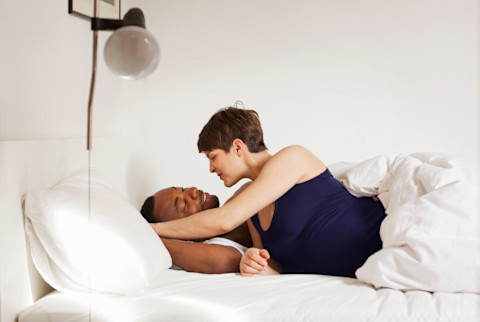What Is A Vaginal Dilator & How Can They Help Reduce Sexual Pain?

Maintaining a healthy sex life can contribute to overall well-being, but it doesn't always come naturally. Some people experience pain during sex, pelvic exams, or any other kind of vaginal insertion. Because of that, the thought of sex can be anything but pleasurable.
Fortunately, there are solutions to alleviate this pain or discomfort. To ease back into having sex that feels good, improve the experience at the OB/GYN, and help manage anxiety or fear around the pain, some health care providers will recommend vaginal dilators.
What is a vaginal dilator?
Vaginal dilators, or vaginal trainers, are a set of tube-shaped devices ranging in sizes from smaller to larger. "They are specifically meant to gently stretch the vaginal canal and manipulate the vaginal tissue," counselor and psychosexual health educator L.P. Watts, LCSW, tells mbg.
Vaginal dilators increase the elasticity of the vagina and keep it from becoming too narrow, which can have a number of benefits. Here are just a few:
- Make penetrative sex more pleasurable and less painful.
- Make pelvic exams less painful.
- Allow your OB/GYN to do a more complete and thorough pelvic exam.
- Decrease anxiety around penetration or any type of insertion into the vagina.
How they work
Sexual trauma, pain with intercourse, and a lack of experience can all trigger anxiety, which can sometimes cause people to tighten up at the thought of insertion. Some people can experience vaginismus1, which is an involuntary muscle spasm in the pelvic floor that can make it painful to have an orgasm, have sex, and use a tampon or vibrator.
Starting with a small vaginal dilator and gradually increasing the size can help relax the pelvic floor muscles and help people get used to the feeling of something inside them, gynecologist Lynley Durrett, M.D., says.
Also, during menopause, the vaginal opening and the labia might get tighter because the skin loses elasticity. "For some people, it gets so tight, it's really hard for them to have penetration," Durrett says. "That's where dilators can help."
That said, people who have frequent sex throughout menopause might not have as many issues with the tightening of the vagina and may not need a dilator, though they may still experience vaginal dryness and may benefit from solutions specific to that challenge.
How to use a vaginal dilator:
- Wash the dilator you plan to use (more on that below).
- Find a comfortable place in your home, whether it's in your bed, in the tub, or on the couch. It's important that you feel at ease.
- Consider doing Kegel or reverse Kegel exercises to help relax the pelvic muscles, and/or meditation and breathwork to calm your anxiety about the penetration.
- Apply a natural lubricant to the dilator and the vaginal opening.
- Lie on your side or on your back with your knees lifted—whichever feels most comfortable.
- Start with the smallest dilator size and insert the rounded end into your vagina, the way you would with a tampon. This first, smallest dilator should not feel uncomfortable when inserted; if it does, go to a smaller size.
- Hold the dilator in your vagina for one to 20 minutes (or however long your health care provider suggests).
- Remove the dilator and wash it again.
When and how often do I use it?
"I recommend repeating this several times a week until comfortable, then moving on to the next size up," Durrett says. Continue repeating this pattern until you've reached the desired dilator size. "Patients do have to be fairly motivated to use regularly to have good results," she adds.
That said, you should avoid using the dilator daily since it could lead to irritation or bleeding. You can always consult with your OB/GYN to figure out if you need a vaginal dilator and how often you should be using it.
How to clean your dilator
Cleaning your vaginal dilator before and after use can help prevent infection from bacteria, fungus, or debris that could otherwise build up on the tool. Read the instructions on the dilator's packaging to figure out the best way to clean it.
According to Durrett, vaginal dilators are best cleaned with a mild, unscented soap (think anything that would be safe to use on the vulva) and warm water. Dry the dilator thoroughly after washing, and package it back up according to the instructions.
(P.S.: You should be cleaning your sex toys regularly, too!)
Products to try
Choosing the right vaginal dilator is a personal choice, Watts says, but here are a few medical-grade options:
Your OB/GYN may also recommend a specific brand, depending on your needs. "The main thing is to get a set that has several sizes," Durrett says.
Whatever the cause of vaginal tightness, using a dilator (with the guidance of your OB/GYN) can help calm your anxieties and reduce pain associated with penetration.
